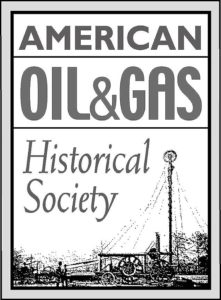by Bruce Wells | Mar 10, 2025 | This Week in Petroleum History
March 11, 1829 – Kentucky Salt Well Driller discovers Oil –
Boring for brine with a simple spring-pole method on a farm near Burkesville, Kentucky, Martin Beatty found oil at a depth of 171 feet. Disappointed, he searched elsewhere. Beatty drilled brine wells to meet demand from settlers needing salt to preserve food. He bored wells by raising and dropping a chisel suspended from a sapling, an ancient drilling technology.
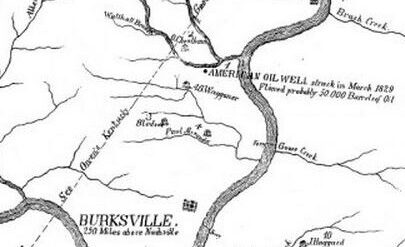
The 1829 “American Oil Well” of Burksville, Kentucky, drilled to find brine, produced oil later bottled and sold as medicine.
Historian Sheldon Baugh described the scene of Beatty’s 1829 oil discovery: “On that day, well-driller Beatty bragged to bystanders, ‘Today I’ll drill her into salt or else to Hell.’ When the gusher erupted he apparently thought he’d succeeded in hitting Hell. As the story goes, he ran off into the hills and didn’t come back.”
Beatty’s discovery would be neglected for years until the oil from his well was sent to Pittsburgh, where Samuel Kier bottled and sold it as medicine. Kier would soon build the earliest refineries for turning oil into kerosene for lamps.
Learn more in Kentucky’s Great American Oil Well.
March 11, 1930 – Society of Exploration Geophysicists founded
The Society of Exploration Geophysicists (SEG) was founded by 30 men and women in Houston as the Society of Economic Geophysicists, to foster “the expert and ethical practice of geophysics in the exploration and development of natural resources.”

The society began publishing its journal Geophysics in 1936, and in 1958 formed a scholarship trust for students of geophysics. In 2021, SEG and the American Association of Petroleum Geologists (AAPG) combined their annual meetings to create IMAGE, the International Meeting for Applied Geoscience & Energy. IMAGE 2025 is expected to attract more than 7,800 attendees to Houston August 25-28.

March 12, 1912 – Thomas Slick discovers First of Many Oilfields
Once known as “Dry Hole Slick,” Thomas B. Slick discovered a giant oilfield midway between Oklahoma City and Tulsa. His No. 1 Wheeler uncovered the Drumright-Cushing field, which produced for the next 35 years and reached 330,000 barrels of oil per day at its peak.

Tom Slick is among those honored at the Conoco Oil Pioneers plaza at the Sam Noble Museum, University of Oklahoma, Norman.
Following Cushing, Slick began an 18-year streak of discovering oilfields in Oklahoma, Kansas, and Texas. His success during the Greater Seminole Oil Boom of the 1920s made him the leading U.S. independent producer with a net worth of up to $100 million.
By 1930 in the Oklahoma City field, Slick completed 30 wells with the capacity to produce 200,000 barrels of oil a day. When he died suddenly the same year from a stroke at age 46, oil derricks in the Oklahoma City field stood silent for one hour in tribute to Slick.
Learn more in Oklahoma’s King of the Wildcatters.
March 12, 1914 – Last Coal Powered U.S. Battleship Commissioned
The USS Texas, the last and most powerful American battleship built with coal-fired boilers, was commissioned. Coal-burning boilers, which produced dense smoke and created tons of ash, required the Navy to maintain worldwide coaling stations. Coaling ship was a major undertaking and battleships carried about 2,000 tons with a crew of “coal passers.”
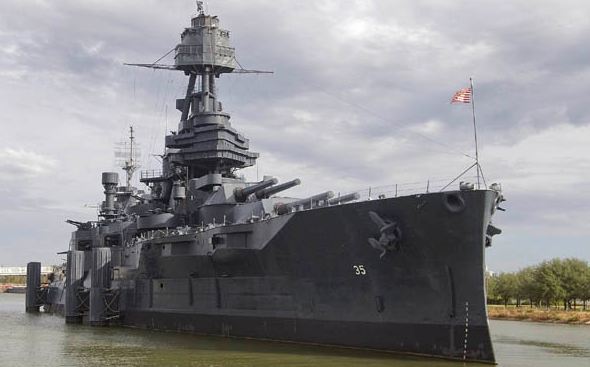
The USS Texas’ coal-powered boilers were converted to burn fuel oil in 1925. Photo courtesy Battleship Texas State Historic Site.
Dramatic improvement in efficiency came when the Navy began adopting fuel oil boilers. By 1916, the Navy had commissioned its first two capital ships with oil-fired boilers, the USS Nevada and the USS Oklahoma. To resupply them, “oilers” were designed to transfer fuel while at anchor, although underway replenishment soon became possible. The USS Texas was converted to burn fuel oil in 1925.
The “Big T” — today the Battleship Texas State Historic Site docked on the Houston Ship Channel — was the first battleship declared to be a U.S. National Historic Landmark. Learn more in Petroleum and Sea Power.
March 12, 1943 – WWII Roughnecks of Sherwood Forest
A top-secret team of 42 American drillers, derrickhands, roustabouts, and motormen boarded the troopship HMS Queen Elizabeth. They were volunteers from two Oklahoma companies, Noble Drilling and Fain-Porter Drilling. Their mission was to drill wells in England’s Sherwood Forest and help relieve the crisis caused by submarines sinking Allied oil tankers.
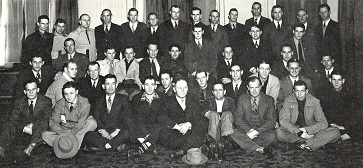
Volunteer roughnecks from two Oklahoma drilling companies embarked for England in March 1943. Derrickhand Herman Douthit would not return.
Four rotary drilling rigs were shipped on separate transport ships — with one sunk by a U-boat. The American roughnecks increased the British drilling rate to an average of one well per week, adding vital oil to the war effort. Learn more in Roughnecks of Sherwood Forest.
March 12, 1968 – Alaska’s Prudhoe Bay Oilfield Discovered
Two hundred and fifty miles north of the Arctic Circle, Alaska’s Prudhoe Bay oilfield was discovered by Richfield Oil (ARCO) and Humble Oil Company (Exxon). The Prudhoe Bay State No. 1 exploratory well arrived more than six decades after the first Alaska oil well. It followed Richfield Oil’s discovery of the Swanson River oilfield on the Kenai Peninsula in 1957.

Beginning in 1979 and continuing until early 1989, the Prudhoe Bay field’s maximum production rate reached 1.5 million barrels of oil a day. Map courtesy Alaska Oil and Gas Conservation Commission. Circa 1969 wellsite courtesy Atlantic Richfield Company.
At more than 213,000 acres, the Prudhoe Bay field was the largest oilfield in North America, surpassing the 140,000-acre East Texas oilfield discovery of 1930. Prudhoe Bay’s remote location prevented oil production beginning in earnest until 1977, after completion of the 800-mile Trans-Alaska Pipeline.
Prudhoe Bay field’s production exceeded an average rate of one million barrels of oil a day by March 1978, according to the Alaska Oil and Gas Conservation Commission. It peaked in January 1987 at more than 1.6 million barrels of oil per day.
March 13, 1974 – OPEC ends Oil Embargo
A five-month oil embargo against the United States was lifted by Arab members of the Organization of Petroleum Exporting Countries (OPEC), a cartel formed in 1960. The embargo, imposed in response to America supplying the Israeli military during the October 1973 Yom Kippur War, created gasoline shortages, prompting President Richard M. Nixon to propose voluntary rationing and a ban of gas sales on Sundays. OPEC ended the embargo after Secretary of State Henry Kissinger negotiated an Israeli troop withdrawal from parts of the Sinai.
March 14, 1910 – Lakeview No. 1 Well erupts in California
The Union Oil Company Lakeview No. 1 well erupted a geyser of oil at dawn in Kern County, California (some sources give the date as March 15). With limited technologies for managing the deep, highly pressured formation of the Midway-Sunset field, drillers had experienced several accidental oil spills, including the Shamrock gusher in 1896 and the 1909 Midway gusher.
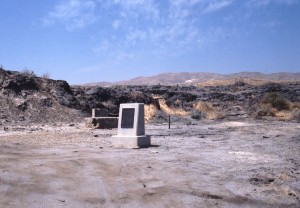
A marker and remnants of a sand berm north of Maricopa, California, mark the site of a 1910 Union Oil gusher that flowed uncontrolled for 18 months. Photo courtesy San Joaquin Valley Geology.
“But none of these wells came close to rivaling the Lakeview No. 1 which flowed, uncapped and untamed, at 18,000 barrels a day for 18 months,” noted a San Joaquin Valley geologist. Surrounded by berms and sandbags to contain the oil, the well collapsed and died in September 1911, after producing 9.4 million barrels of oil (about half was contained and sold).
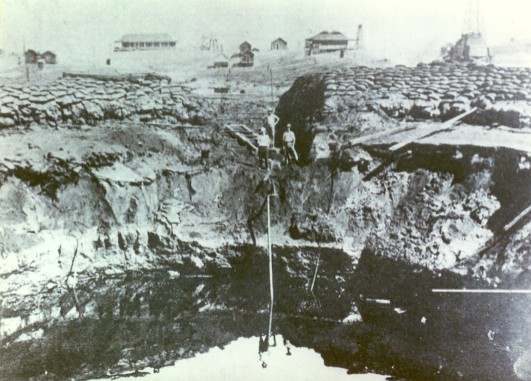
Oil erupted in California’s Midway-Sunset oilfield on March 14, 1910. Contained by sandbags by October, the Lakeview No. 1 well produced 9.4 million barrels during the 544 days it flowed. Photo courtesy San Joaquin Valley Geology.
The environmental impact of the Lakeview well, still the largest oil spill in U.S. history, was less destructive due to evaporation and levees of sandbags that prevented contamination of Buena Vista Lake.
Kern County erected a historic marker in 1952 at the site, today about seven miles from the West Kern Oil Museum. The ram-type blowout preventer to seal well pressure was invented in Lufkin, Texas, in 1922.
March 15, 1946 – Texas Independents produce TIPRO
With oilfield discoveries resulting in overproduction, declining prices, oilfield thefts, and policy disagreements with the major oil companies, Texas independent producers formed an association to lobby federal and state lawmakers. The Texas Independent Producers and Royalty Owners Association (TIPRO) was established “to preserve the ability to explore and produce oil and natural gas and to promote the general welfare of its members.”

March 16, 1911 – Pegasus Trademark takes Flight
A Vacuum Oil Company subsidiary in Cape Town, South Africa, trademarked a flying horse logo inspired by Pegasus of Greek mythology. Based in Rochester, New York, Vacuum Oil had built a successful lubricants business long before gasoline was a branded product.
When Vacuum Oil and Standard Oil of New York (Socony) combined in 1931, the Socony-Vacuum Oil Company adopted the winged horse trademark and marketed Pegasus Spirits and Mobilegas products.
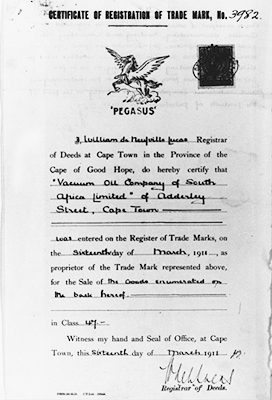
The original Mobil Pegasus logo was registered in 1911 by the South African subsidiary of New York-based Vacuum Oil Co.
A stylized red gargoyle earlier had advertised the company, which produced petroleum-based lubricants for carriages and steam engines. Created by the Vacuum Oil Company of South Africa, the Pegasus trademark proved to be a far more enduring image.
Learn more in Mobil’s High-Flying Trademark.
March 16, 1914 – “Main Street” Oil Well completed in Oklahoma
A well completed in 1914 produced oil from about 1,770 feet beneath Barnsdall, Oklahoma. The popular TV program Ripley’s Believe It or Not would proclaim the well the “World’s Only Main Street Oil Well.”
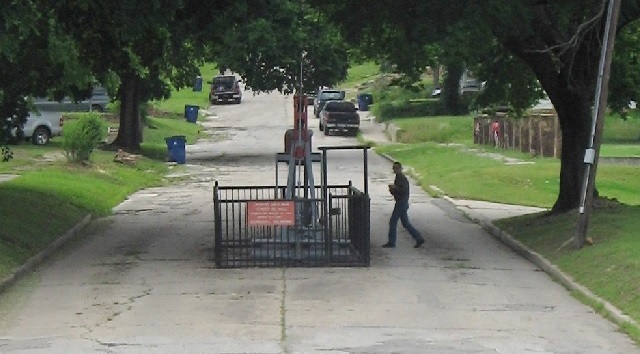
An oil well pump in the middle of Main Street in Barnsdall, Oklahoma, was visited by American Oil & Gas Historical Society volunteer Tim Wells in 2016. Photo by Bruce Wells.
The town originally was called Bigheart, named for Osage Chief James Bigheart, who on behalf of the Osage people in 1875 signed the first lease for oil and gas exploration, according to Osage County. In 1922, Barnsdall was renamed for Theodore Barnsdall, owner of the Barnsdall Refining Company, which was later acquired by Baker Hughes. The “Barnsdall Main Street Oil Well” was added to the National Register of Historic Places in 1997.
_______________________
Recommended Reading: Trek of the Oil Finders: A History of Exploration for Petroleum (1975); A Geophysicist’s Memoir: Searching for Oil on Six Continents (2017); “King of the Wildcatters:” The Life and Times of Tom Slick, 1883-1930
(2017); “King of the Wildcatters:” The Life and Times of Tom Slick, 1883-1930 (2004); Historic Battleship Texas: The Last Dreadnought
(2004); Historic Battleship Texas: The Last Dreadnought (2007); The Secret of Sherwood Forest: Oil Production in England During World War II
(2007); The Secret of Sherwood Forest: Oil Production in England During World War II (1973); Discovery at Prudhoe Bay Oil
(1973); Discovery at Prudhoe Bay Oil (2008); San Joaquin Valley, California, Images of America
(2008); San Joaquin Valley, California, Images of America (1999); Oil in Oklahoma
(1999); Oil in Oklahoma (1976).
(1976).
_______________________
The American Oil & Gas Historical Society (AOGHS) preserves U.S. petroleum history. Please become an annual AOGHS supporter and help maintain this energy education website and expand historical research. For more information, contact bawells@aoghs.org. Copyright © 2025 Bruce A. Wells. All rights reserved.
by Bruce Wells | Mar 3, 2025 | Petroleum Pioneers
Derricks in the Oklahoma City Oilfield in 1930 stood silent for one hour in tribute to Tom Slick.
Once known as “Dry Hole Slick,” wildcatter Thomas B. Slick discovered Oklahoma’s giant Cushing oilfield in 1912 and became known as the “King of the Wildcatters.” Today Cushing is the “Pipeline Crossroads of the World,” the trading hub for oil in North America – and the daily settlement point for prices, including West Texas Intermediate.
The owner of Spurlock Petroleum Company, Alexander Massey, enjoyed great success in the Kansas oilfields after finding oil or natural gas in 25 consecutive wells. In 1904, Massey hired an inexperienced 21-year-old “lease man” named Thomas Baker Slick for a 25 percent share in all the leases the young man could secure. They went to Tryon, Oklahoma, to look for oil.
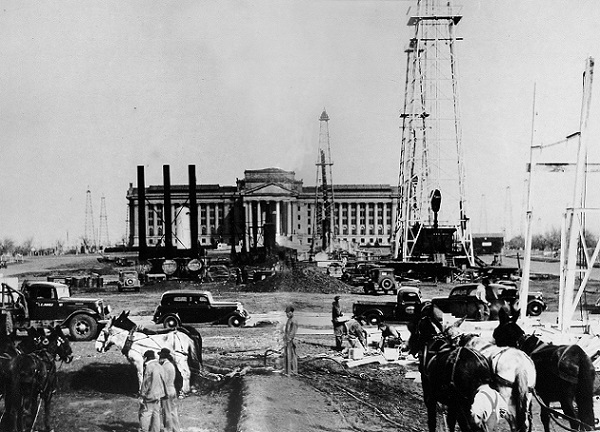
When Oklahoma’s “King of the Wildcatters” Thomas B. Slick suddenly died from a stroke at age 46 in 1930, the oil derricks in the Oklahoma City field stood silent for one hour in tribute. Photo courtesy Library of Congress.
Massey later recalled that Slick, born in Shippenville, Pennsylvania, in 1883, showed a talent for securing petroleum leases. “Tom would go out and lease most of a territory as yet unproved or doubtful as to oil prospects,” Massey noted. “But he’d spread as clean a bunch of leases before a capitalist as you’d wish to see…He certainly knew what a good oil lease was.”

Spurlock Petroleum Company spudded an exploratory well on the farm of M.C. Teegarden near Tryon. As Slick continued securing leases that eventually totaled more than 27,000 acres, drilling generated excitement in the local newspaper and with other Oklahoma wildcatters.
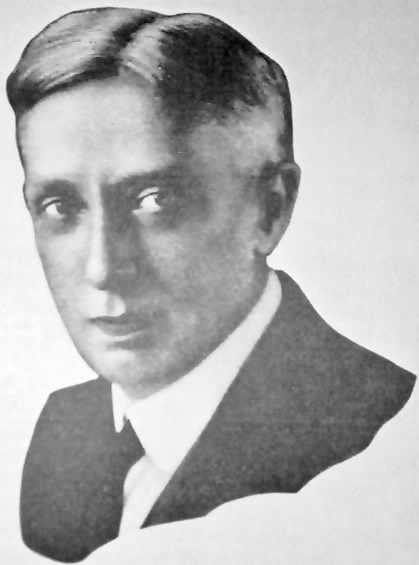
Once known as “Dry Hole Slick” by many, on March 12, 1912, Thomas B. Slick discovered Oklahoma’s giant Cushing oilfield.
However, at a depth of 2,800 feet with no signs of oil, Spurlock Petroleum and owner Massey ran out of money. Tom Slick’s first well was a dry hole. It was the first of many.
Dry Hole Slick
In 1907, after another dry hole near Kendrick, Oklahoma, Slick left the employ of Massey and headed for Chicago, Illinois. Charles B. Shaffer of the Shaffer & Smathers Company hired Slick for $100 per month (and expenses) to find and secure promising oil leases.
Slick traveled to Illinois, Kentucky, western Canada, and eventually, back to Oklahoma. While leasing for Shaffer & Smathers, the young oilman drilled at least ten dry holes in Oklahoma, earning his unenviable nickname, “Dry Hole Slick.”
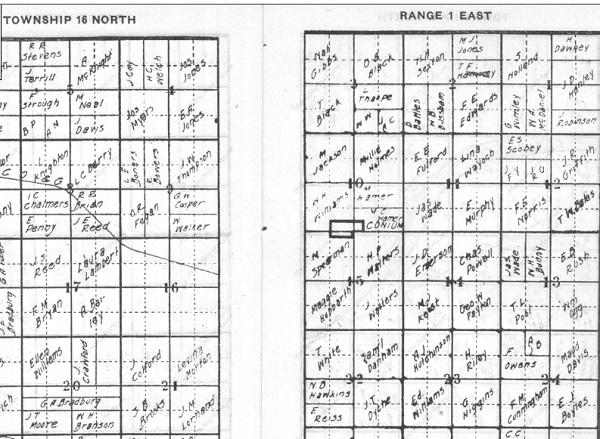
An example of township leases similar to those negotiated by Tom Slick, from the Atlas of North Central Oklahoma 1917 Oil Fields and Landowners: Oklahoma, M. P. Burke, 1917.
The Bristow Record newspaper reported that Slick, “continues to gamble on wild cat stuff. Few men have stuck to the wildcatting longer and harder than Slick and associates. It is said he has spent $150,000 mostly on dry holes.” Now also known as “Mad Tom” Slick, he tried his luck again just 35 miles down the road, in Cushing.
As “Mad Tom” pursued new leases in 1912, publications like the Cushing Independent encouraged readers to take advantage of leasing opportunities. “Land owners have everything to gain and no risk to themselves in making leases,” the newspaper reported on January 25.

“It costs from $8,000 to $10,000 to put down a single hole,” the newspaper noted. “Unless the promoters can get the leases they want they will not chance their money here, while other localities are eager to give leases and even bonuses in money to get prospecting done.”
The Cushing Democrat added, “We would repeat that we believe it to the best interests of the individuals and all that these leases be granted…And just a word of warning. If you make a lease see that the lessee’s name is not left blank, but that the name of Thomas B. Slick is there.”
Slick and Charles Shaffer spudded a wildcat well on the farm of Frank M. Wheeler in January 1912.
Gusher at Cushing
On March 12, 1912, the Wheeler No. 1 well struck oil, producing about 400 barrels a day from a depth between 2,319 and 2,347 feet. It marked Tom Slick’s first gusher — and a giant oilfield discovery. Slick was so secretive about his find that he even cut the phone line to the Wheeler house to prevent word from spreading.
Knowing that exploration companies and speculators would descend in droves on the town once word got out, Slick protected his investment. Just how he did so would be described by a frustrated competing lease man to his boss:
You see, sir, Slick and Shaffer roped off their well on the Wheeler farm and posted guards and nobody can get near it…I got a call yesterday at the hotel in Cushing from a friend who said they had struck oil out there. A friend of his was listening in on the party line and heard the driller call Tom Slick at the farm where he’s been boarding and said they’d hit.
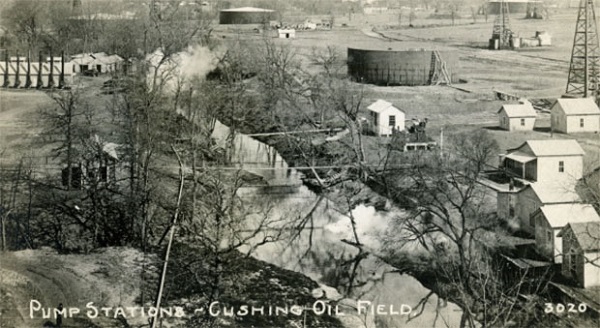
Pump stations in the Cushing oilfield, 1910-1918, from the Oklahoma Historical Society. More than 50 refineries once operated in the Cushing area about 50 miles west of Tulsa. Pipelines and storage facilities have since made it “the pipeline crossroads of the world.”
Well, I rushed down to the livery stable to get a rig to go out and do some leasing and damned if Slick hadn’t already been there and hired every rig. Not only there, but every other stable in town. They all had the barns locked and the horses out to pasture. There’s 25 rigs for hire in Cushing and he had them all for ten days at $4.50 a day apiece, so you know he really thinks he’s got something.

I went looking for a farm wagon to hire and had to walk three miles. Some other scouts had already gotten the wagons on the first farms I hit. Soon as I got one I beat it back to town to pick up a notary public to carry along with me to get leases — and damned if Slick hadn’t hired every notary in town, too.
Eleven days later the news had spread. As a leasing frenzy grew the Tryon Star reported, “Our old friend Tom Slick the oilman has struck it rich…Slick has been plugging away for several years and has put down several dry holes…He deserves this success and here’s hoping that it will make Tom his millions.”
New King of the Wildcatters
Tom Slick’s No. 1 Wheeler was the discovery well for the prolific Drumright-Cushing oilfield, which produced for the next 35 years, reaching 330,000 barrels every day at its peak.

Oklahoma’s Drumright Historical Society Museum includes the town’s 1915 Santa Fe Railroad Depot, which is listed in the National Register of Historic Places.
Slick was suddenly a very rich man. After his dramatic success in Drumright and Cushing, he began an incredible 18-year streak of discoveries in some of the nation’s most prolific oilfields. Visit the Drumright Historical Society Museum.
Slick was active in the Seminole Area, especially the oilfields of Pioneer, Tonkawa, Papoose, and Seminole. He secured leases and drilled wells that consistently paid off.
Slick’s oil gushers were spectacular: No. 4 Eakin — 10,000 barrels per day; No. 1 Laura Endicott — 4,500 barrels per day; No. 1 Walker — 5,000 barrels per day; No. 1 Franks — 5,000 barrels per day (see Greater Seminole Oil Boom).

Reflecting on his fortunes late in his career, he noted, “If I strike oil everyone calls it Tom Slick’s luck, (but) I call it largely judgment based upon experience. Some folks don’t recognize good luck when they meet it in the middle of the road. So I have been fortunate, or lucky, whichever you call it, but I’ve also done a lot of calling good luck to bring it my way.”
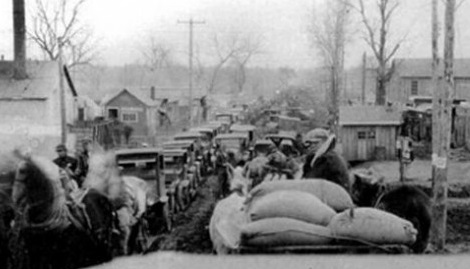
Newly discovered oilfields of the mid-1920s brought prosperity — and traffic jams — to Seminole, Oklahoma. Photo courtesy Oklahoma Oil Museum.
Slick’s leases in Oklahoma, Kansas, and Texas produced millions of barrels of oil. Production from his wells reached 35,000 barrels of oil a day in 1929, and he was proclaimed the largest independent oil operator in the United States with a net worth estimated from $35 million and up to $100 million.
By 1930, in the Oklahoma City field alone, Slick had 45 wells being drilled, more than 30 wells completed, and the capacity to produce 200,000 barrels of crude daily. Across the Mid-Continent, stories of Tom Slick’s business acumen and integrity grew with his fortune.
It was often told how Slick once closed a $100,000 deal for a prized Seminole lease on a street corner. He met the owner on the street and inquired, “What do you want for that lease’ ‘A hundred thousand dollars,’ replied the owner. ‘It’s a sale, bring in your deeds,’ said Slick.”

Thomas B. Slick is among those honored at an outdoor plaza at the Sam Noble Museum, University of Oklahoma, in Norman.
Thomas B. Slick’s death from a stroke in August 1930 at the age of 46 abruptly ended an oilfield career that had supplied America with the petroleum it needed to grow.
“Oil derricks in the Oklahoma City Field stood silent for one hour in tribute,” reported the Oklahoma Historical Society. Slick’s biggest strike came a week after he died when his Campbell No. 1 well in Oklahoma City produced 43,200 barrels of oil per day.
Stories about the “King of the Wildcatters” and his oilfield discoveries would spread across the Mid-Continent. Thomas B. Slick, — no longer known as “Mad Tom” or “Dry Hole Slick” — joined other Oklahoma petroleum industry leaders honored at the Conoco Oil Pioneers of Oklahoma Plaza.

By the end of the 20th century, more than one-half million Oklahoma oil and natural gas wells were drilled since an oilfield discovery at Bartlesville in 1897 (learn more in First Oklahoma Oil Well).
More about Slick and his extraordinary oilfield career can be found in King of the Wildcatters, the Life and Times of Tom Slick, 1883–1930 by Ray Miles, professor of history and dean of the College of Liberal Arts at McNeese State University, Lake Charles, Louisiana.
For example, Miles relates that in 1933, a friend and business partner of the Oklahoma wildcatter was kidnapped and held for ransom. Once released, Charles Urschel assisted the FBI in catching his abductors, including George “Machine Gun” Kelly, who was sentenced to life in Alcatraz.
_______________________
Recommended Reading: King of the Wildcatters, the Life and Times of Tom Slick, 1883–1930. (2004); The Oklahoma City Oil Field in Pictures (2005); The Oklahoma Petroleum Industry
(2005); The Oklahoma Petroleum Industry (1980). Your Amazon purchase benefits the American Oil & Gas Historical Society. As an Amazon Associate, AOGHS earns a commission from qualifying purchases.
(1980). Your Amazon purchase benefits the American Oil & Gas Historical Society. As an Amazon Associate, AOGHS earns a commission from qualifying purchases.
_______________________
The American Oil & Gas Historical Society (AOGHS) preserves U.S. petroleum history. Become an AOGHS annual supporter and help maintain this energy education website and expand historical research. For more information, contact bawells@aoghs.org. © 2025 Bruce A. Wells. All rights reserved.
Citation Information – Article Title: “Oklahoma’s King of the Wildcatters.” Authors: B.A. Wells and K.L. Wells. Website Name: American Oil & Gas Historical Society. URL: https://aoghs.org/petroleum-pioneers/wildcatter-tom-slick. Last Updated: March 1, 2025. Original Published Date: December 1, 2004.



















